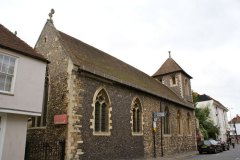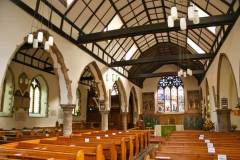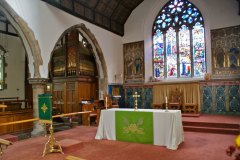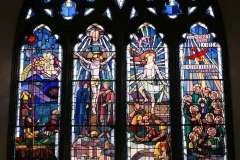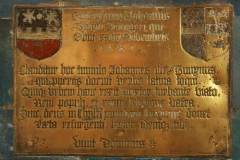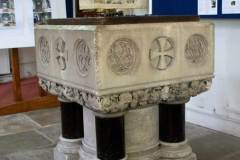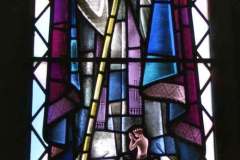Church Street (St Paul’s )
Introduction
St Paul’s church lies close St Augustine’s Abbey, from whose original dedication to St Peter and St Paul the church takes its name.
History
The church may possibly stand on the site of a Roman cemetery chapel, as it is situated just outside the Burgate, close to where Roman burials have been excavated. The original very early 13th century church consisted of only part of the current north aisle, which still contains the original piscina for washing the sacred vessels in the northern wall. Later in the same century the first tower was built and the southern wall broken through to allow the current nave added, although originally as a southern aisle. Later still the first recorded vicar Hamo Doge created the chancel where the organ now stands. In the 14th century the chancel was transferred to an extension to southern aisle which then became the nave. It united with St Martin’s church in 1681.
In 1847 Sir George Gilbert Scott undertook a typical Victorian refurbishment, including building the current south aisle, inserting the decorated style windows, raising the tower and adding the vestry. The rector at the time was William Chessyre, who later became a rural Dean of Canterbury and one of the six preachers of the Cathedral.
The church parishioners had the right of burial in the lay cemetery at St Augustine’s Abbey until its dissolution in 1539. Land at the corner of Longport and Lower Chantry Lane was acquired for a cemetery in 1591 but this was closed in 1953 and handed to the council who moved the gravestones to the edge of the site to create a public space which still exists today. Details can be viewed at http://www.machadoink.com/St Pauls Cemetery.htm
What to see
- The north elevation of the church with the original 13th century wall still visible at the western end in rougher and slightly lighter stone (Image 1).
- The internal view from the west, the original 13th century church now forming the north aisle (2)
- The presbytery with the organ in the north aisle (Image 3).
- The modern east window retaining below a brass dedication plaque to John Chessyre to whom the previous window destroyed in World War II was dedicated (Image 4).
- The memorial to John Twynne (1501 – 1581), the first headmaster of King’s School, on its re-establishment following the dissolution of the monasteries. He became Mayor of Canterbury in 1553 and later Member of Parliament for the city. He was sent to the Tower for some of his beliefs and eventually lost his positions when Elizabeth I came to the throne (Image 5).
- The font in the north aisle (Image 6).
- Detail from west window of St Augustine, reflecting the links with the abbey (Image 7).
Access: The church is normally only open for services, access at other times can be arranged through the contacts at http://www.martinpaul.org/index.htm
Sources: http://www.machadoink.com/St Pauls Church.htm
SR

